Updated: 10-Dec-2019
ALFA (Anonima Lombarda Fabbrica Automobili) has been founded in 1910 and in 1915 Nicola Romeo joined. At the end of WWI the company's name became Alfa-Romeo.
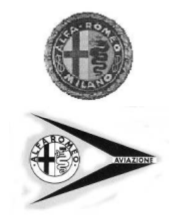
"Alfa Romeo logos"
-When the brand won the car world championship in 1925, they started to manufacture aviation engines. The engines had 6 cylinders and gave 24 CV. They were converted car engines (1910).
-It was named “Societá per Azioni Alfa Romeo” (Alfa Romeo Spa), in Milan. Today the aviation section of this company is known as "Alfa Romeo - AVIO".
-During the first year of activity they acquired the license for building the UK Bristol "Jupiter" engine.
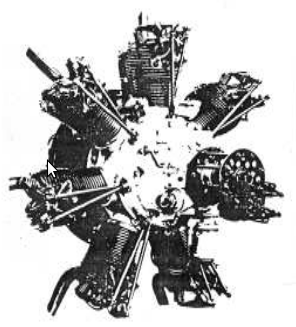
“Lynx-Alfa Romeo”
-Around 1928 they did the same with the "Lynx" from Armstrong Siddeley, classified as medium power (200 CV).
-It was a radial engine that was designed in 1921, wherefore it could not be considered to be a modern engine for that time but was tested out very well.
-These engines were mounted in the Breda 19, 25 y 28, various Caproni, Piaggio, Fiat and CNA.
-A curious case is the Caprioni CA-100 airplane. In this aircraft they installed an Alfa Romeo "Grand Sport" 1750 V 12 engine with a Roots turbocharger. The plane took part in the Giro Aereo in Italy in 1931.
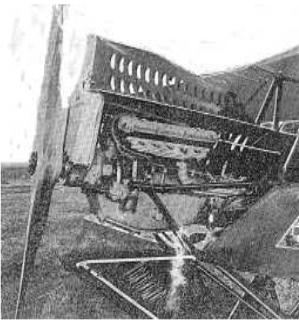
“Alfa Romeo mounted in the Caproni Ca-100”
-In 1930 the company built its first engine of original design, the D-2.
We located an Alfa radial engine known as model D with 9 cylinders giving 225 CV and that was offered with or without gear and with or without supercharger.
-With supercharger it gave 230 CV up to 3,000 meters of altitude.
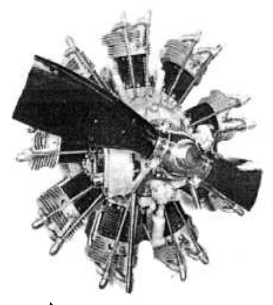
“Alfa D”
-During WWI they repaired aviation engines of other brands.
-It was around 1925 when they began to build aviation engines themselves. They started with building the Bristol Jupiter (model IV) under license, that came out the following year 1926.
-The next engine under license was the Armstrong Siddeley Lynx.
-As from 1929 they started the "D" series, where strangely the D referred to "Dux" (is Latin for leader)
The D1 and D2 gave 240 CV. The D2C30 gave the power at 3,000 meters. The D4, remained experimental.
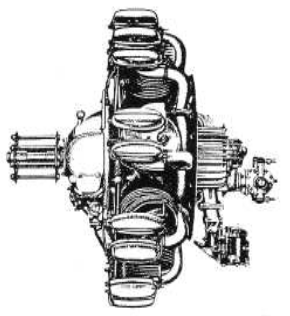
“Alfa Romeo D2”
-The first engine was perhaps the 6-cylinder car engine from 1910. Adapted by the mechanic N. Franchini for A. Santoni's biplane.
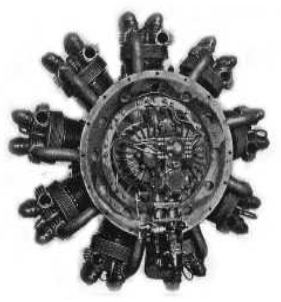
“Alfa Romeo D2C-30”
-Continuing with the chronological order of appearance, the next date is not clear as it is between 1931 and 1932 when the liquid-cooled 6-cylinder inline 6CA engine came out. It gave 80 CV.
-Between 1932 and 1934 they were building Bristol engines under license again, the Mercury IV (Mercurio IV) and the Pegasus in three versions, the Pegaso S2, AQ and SAQ. These engines gave between 500 CV and 580 CV.
-In 1933 they built the four-cylinder in-line, air-cooled 110 model starting with version I, later the "bis" in 1938 and finally the "ter" in 1948.
-In 1935 they built the 6-cylinder engine that was based on the former 4-cylinder engine. It is the 115-I, then the "bis" in 1940 and in 1948 the "ter" is made.
-The latter is said to have been specially constructed to have 3000 hours between overhauls instead of the common 150 hours. They gave 190 to 215 CV.
-A hardly known 116-I, was similar to the previous engines and gave 210 hp. The concrete date of appearance is not known.
-The 9-cylinder radial engine models 125 (RC35, RC10, etc) came out as from 1934. They gave from 650 to 710 CV.
-They continued with the plan of acquiring Bristol licenses in the early 1930's. They made the "Mercury" and "Pegasus".
-With the experience gained from all these engines, they started an extensive design and construction program for original engines.
-They also continued with others such as the 110 with 157 CV, the 115 with 225 CV and the 121 with 400 CV. These engines were manufactured until 1956.
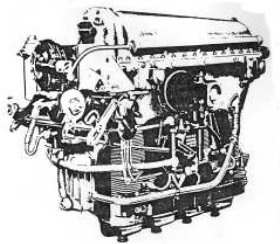
“Alfa 110-I”
-The 110-I was De Havilland "Gipsy" under license. (with English designer Halford's strong intervention). It had remarkable features and easy maintenance.
-In 1938 they released the "bis" version with some detail enhancement, but without changing the characteristics.
-In 1948 the "ter" version came out with a major compression relation and giving 120 cv at 2,250 rpm.
-Another variant of 110-ter was mounted in the Augusta CP110, among others. All of them had four inverted cylinders.

“Alfa 110ter”
-The Alfa Romeo 115-I was an inverted 6-cylinder in line, air-cooled engine. It was a development of the 4-cylinder engine and gave 205 CV at 2,360 rpm. They were mounted in the Fiat G-46. The 115-ter version reached 225 CV.
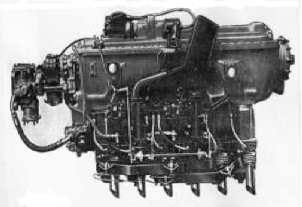
“Alfa 115ter”
-The Alfa Romeo 121, designed by Orazio Satta Puliga was an air-cooled, inverted, V-8 engine (remember the German Argus).
-This engine was manufactured in small production and in its different versions it gave between 350 and 400 CV with compressor.

“Alfa 121”
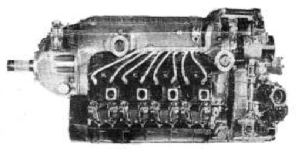
“Alfa 121, side view”
-In this side view of the 121 we see the body where the mechanical compressor will be mounted.
-As mentioned, in 1931 Alfa had building licenses for the Bristol "Mercury-IV" and "Pegasus" engines, the latter was derived from the famous "Jupiter", designed by the Englishman Roy Fedden.
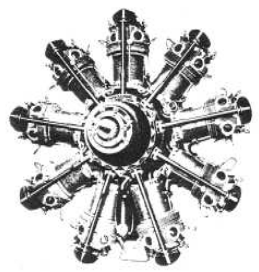
“Alfa 126RC34”
-From the "Pegasus" they made the Alfa Romeo 126RC34 nine-cylinder star engine with more power, gear and compressor for multiengine airplanes. They were mounted in the Cant Z206bis, the Junkers Ju-52 and a long range of SIAI Marchetti.

“Alfa 126RC34”
-Initially they were known as "Pegasus" and in 1934 as Alpha 125 in the 650 and 710 CV versions.
-In 1936 they were known as 125 and then in 1937 they derived the 127 and 128, this latter already gave 860 CV and was mass-produced.
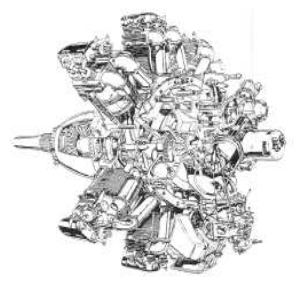
“Alfa Romeo 126RC34, cutaway drawing”
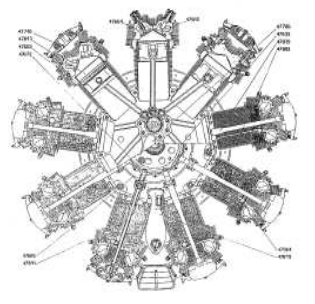
“Alfa 126RC34”
-The 128, which is shown below, is a powerful 9-cylinder engine with gear and supercharger. It displaces 28.628 liters and has four valves per cylinder, inclined to the cylinder axis.

“Alfa 128”
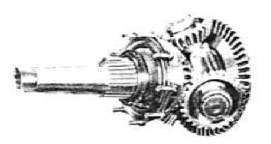
“128 gear details”
-So in 1935 the 126 (RC 34, RC10) are available and giving 750 to 800 CV.
-The model 127 is from 1937, with 800 CV. But RC50 or RC55, which means that they maintain this power at an altitude of 5,500 meters, which is great.
-The 128 is from the year 1938 giving 860 CV at 2,300 rpm. The 131 model is from 1943 with 940 CV.
-The 135 was already a twin row radial engine with 18 cylinders giving 1,410 CV.
-During WWII they made the 138 RC23 and RC65 versions with 18 cylinders as well.
-In 1943 there was a 28-cylinder radial engine giving 1,900 CV, which apparently did not go into production.
-The 150 RC41 was an inverted 12-cylinder, liquid-cooled engine that gave 975 CV. It was from the year 1940. (1050RC41?).
-In 1941 Alfa Romeo built the Daimler Benz DB-601 as the RA1000 that gave 1,170 CV for the MC202 and Re2001 aircraft. It was in the middle of WWII, when Italy was allied with Germany.
-In 1943 there is the 111, an inverted inline 4-cylinder air-cooled engine that gave 155 CV.
-The 121 (see main text) were inverted V8 engines (Argus license) giving from 330 to 355 CV as basic engines, RC14 or RC22. They were made from 1943 to 1948.
-Finally we come to the 122 model that was built as from 1951. It was a 12-cylinders inverted V engine giving 510 CV.
-Now we add a new obtained picture of the 115-I engine.

“Alfa Romeo 115-I”
-In "oldengine.org" they announced that the Alfa Romeo V6 engine is an Aero engine. They also built nice V12 engines, but they were possibly automotive engines, at least those designed by Ricart (Wifredo Ricart, see).

“Beautiful design of Wifredo Ricart's V6 engine”
-Wifredo Ricart, was an engineer born in Barcelona (Spain) who was with Alfa Romeo around WWII and who, besides his automobile designs, made the 101 aviation engine, which is described at the end of this chapter. Apart from the references to the Wifredo Ricart and Ricart chapters made in the previous paragraph.
-Going back a little we showed the epicyclic reduction gears used in the 128.
-The Alfa Romeo 131RC14/50 9-cylinder star engine was installed in the four-engine SIAI Marchetti S-95 aircraft giving 1,130 CV at 2,500 rpm. It was supercharged.
-During the postwar the Alfa 121, 125, 126, 128, 135 and 136 are used regularly.
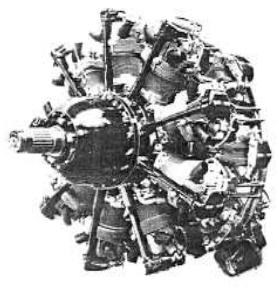
“Alfa 135RC32”
-The Alfa Romeo 135 was a 18-cylinder twin row star engine, on account of Giustino Cattaneo, was made by coupling two "Mercury" engines. It gave 1,410 CV at 2,400 rpm. It was not a great success.
-In the period of the Second World War, Alfa Romeo manufactured, under license, the RA-1000 engine (known as "Monsone") under the direction of Hans Nibel. It was the Daimler-Benz DB-601 Aa.

“Alfa RA1000”
-Intended for the Aermacchi MC-202 aircraft, among others. They also began building the DB-605 in an inverted V version, but without significant continuity.
-After the war, they overhauled and built partly in joint programs with other brands and for the own Italian or European and American aeronautical services, according to the partnerships. They built the following engines:
-Cooperation with Fiat for the CurtissWright R-1820.
-The “Dart”, “Avon”, “Conway” and “Gnome” from Rolls-Royce. The J-85, T-64, CF-6 and J-79 from General Electric.
-The JT-3, JT-8, PT-6 from Pratt and Whitney; The T-56 from Allison and the RB-199 from Turbo Unión.
-In the 1970s, Alfa Romeo developed a small turboprop, similar in appearance to Garrett TPE-331, called AR-318. It was the first to be produced in Italy and gave 660 CV to the shaft, but it did not reach the market.

“Alfa AR-318”
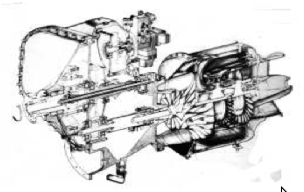
“Alfa AR-318, cutaway drawing”
-Another turbine that was built by Alfa Romeo was the AR TJ-140 destined to low altitude missiles. It competed with the French Microturbo TRS-18, giving 136 kgf of thrust with only 40 kg of weight.
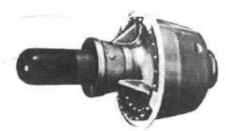
“Alfa AR TJ-140”
-Addendum to this chapter of Alfa Romeo in honor of Ricart. In the days when Wifredo Ricart was the brand's designer, he made racing cars like the 162 and the 512 during the thirties and the mid-forties.
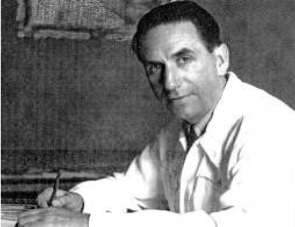
“Wifredo Ricart”
-The 162 car was a 16-cylinder V and the 512 a 12-cylinder horizontally opposed. They had a beautiful appearance as we can see by the latter.

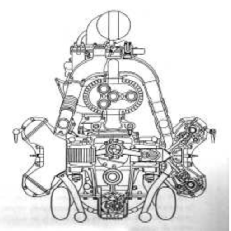
"Motor del Alfa-Romeo 512"
-Being in the Alfa-Romeo factory we are surprised about the construction of a huge 2,000/2,300 CV aviation engine, the 101 RC37/87. Unknown until now in all publications related to the brand. It is found in their private documents.
-But about the engine's construction, it is clear that it was a fact.
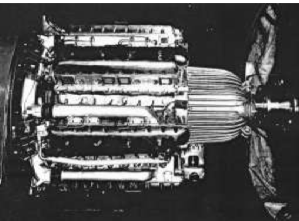
"The Alfa Romeo 101 RC37 / 87"
-It had 7 rows of four cylinders arranged radially.

“Complete view of the 101”
-In this last picture we can see the mechanical compressor of a respectable size. We also note that it is separated from the engine just as presented in his patent that appears in the chapter named Wifredo Ricart (see).
-And more detailed in this "blueprint", we can see that there are two superchargers arranged side by side at the rear of the engine.
-It seems that he also took part in the development of other aircraft engines such as the Alfa-Romeo 126.
-He continues designing cars for the brand including private cars.
-After WWII he decides to return to Spain and enters in CETA as a director together with 14 engineers brought from Italy to be his collaborators. Later he goes to Hispano-Suiza / ENASA, where he opens another Ceta office, close to the place where they are building engines and vehicles.
-In the first designs they made in the factory of La Sagrera in Barcelona you could notice the influence of Alfa-Romeo. The company's brand is going to be known as Pegaso.
-See "Wifredo Ricart" for details of the AR-1100 (-100) and AR-1101 (-101) engines.

“Diagram of various views of the 101”

“The Pegaso horse without wings”
-In the early 1950's they made trucks, buses and a unique car, the Z-102, remarkable for its time and the circumstances that existed in Spain.
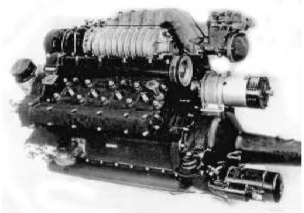
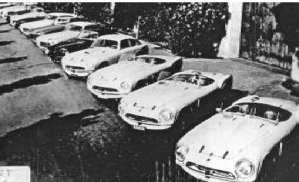
“Engine and line of Z-102s”
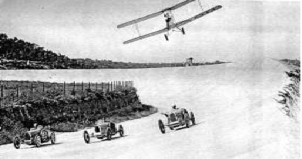
"A curious Photograph from the 1920's with Wifredo Ricart
in his Gipsy Moth plane, flying over some Ricart racing cars
at the Terramar autodrome circuit at Sitges, Spain."
From appendix 6: We obtained new engine photos of the Alfa Romeo brand like the D2-C30 from 1931.

“Alfa D2-C30”
-As is known, the Neapolitan engineer Nicola Romeo took over the brand ALFA in Milan. (Anonima Lombarda Fabricca Automobili), converting it later in Alfa Romeo.
-From this brand they split an aeronautical division in the form of the "Industrie Aeronautiche Romeo" corporation that was destined to manufacture aircraft and engines.
-Initially they manufactured engines under British license and specially engines from Italian "Isotta Fraschini". In the late 1930's and no longer with Nicola in the company, it was taken over by IRI, the newly created industrial group in the public sector . It became Alfa Avio.

“Alfa Avio 126-RC34”
-Here is a side-view picture of the Alfa 125-RC35 that gives 580 CV.

“Alfa Avio 125-RC35”
-And the Alfa 110-CI that gives 130 CV under DeHavilland license.
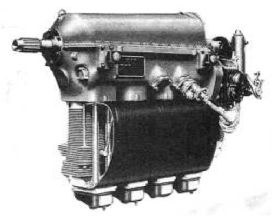
"Alfa Romeo 110-I”
-From the British Bristol company they made the Lynx, Mercury, Jupiter and Pegasus under license.
-We now have a picture of the Pegasus engine, built by the Italian company between 1935 and 1936.

“Alfa Pegasus”
-We now present an unpublished photograph until recently of the AR Avio 129. This engine remained as prototype and it did not enter the production line.
-Below we see it in motion, on a test bench with spinning propeller and, very curious, as it is in a dark place, we can see escape flames coming out through the two short outlets of each cylinder.

“Alfa Romeo Avio 129”
-In this chapter expansion we review the 18-cylinder AR 135 that was built between 1937 and 1944.
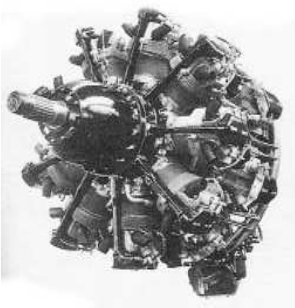
“Alfa 135”
-The AR-1000 under German license from Daimler Benz. Sometimes it was named RA-1000.
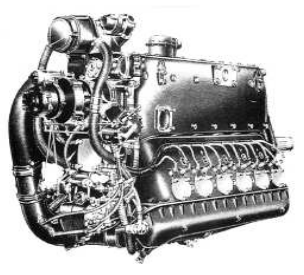
“AR-1000”
-And the Alfa 131 RC.14/50 giving 800 CV. From 1939.
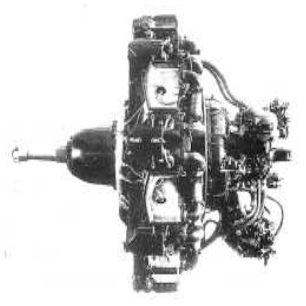
“Alfa Avio 131 RC.14/50”
-A new picture of the Alfa Romeo D2 model, now without propeller it shows us two magnetos in the front of the engine, like the Wright J5.
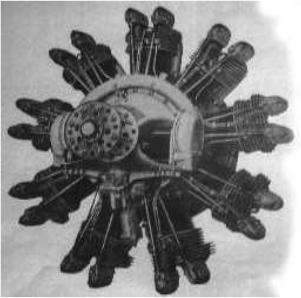
“El Alfa D2”
-This 9-cylinder radial engine was built by Alfa Romeo in Milan with compressor and the maximum power that it gave at an altitude of 2,250 meters was 310 CV at 2,200 rpm equivalent to a power of 390 CV at sea level.
-There appears another engine of this brand with the AR-1759 specification . It clearly has the same style as the car engines designed by Wifredo Ricart, who was directing the brand's technical office before and during WWII.
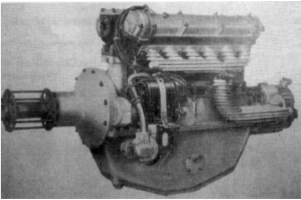
“Alfa Romeo AR-1759”
-It looks like an upright inline six-cylinder engine because of the exhaust outlets and a possible gearbox if the center of the crankshaft coincides with the junction to the engine block and the crankcase oil sump.
-The engine's design is similar to the W. Ricart V6 engine that appears in the main text.
From appendix 10: We found a higher quality photograph than the one that appears in the main text.
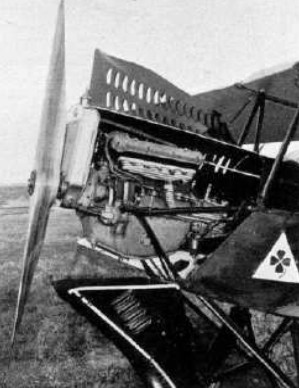
"AR 6C 1750cc"
-We continue this addendum with an Alfa Romeo ad from the 1930's.

"Advertisement from the 1930’s"
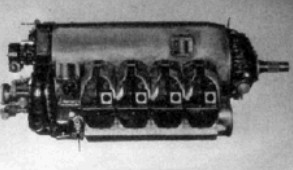
"Unpublished AR-121 picture"
-Here we also include an extended triptych for the AR-128.

"AR-128 radial engine with 18 cylinders in two rows, diagram"
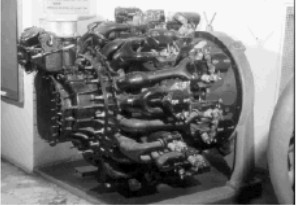
"AR-135-RC32 Museum photograph"
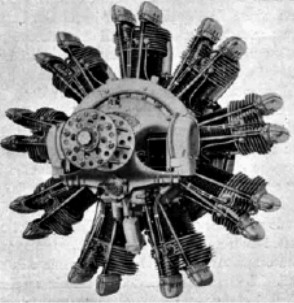
"Alfa Romeo D-2 repeated picture"
Engines of ALFA ROMEO
Model: 101 RC37 / 87

"complete view of the 101"
Model: 110-I, I-bis, I-ter

"Alfa Romeo 110-I"
Model: 111
Model: 115-I, I-bis, I-ter

"Alfa 115ter"
Model: 116-I
Model: 121

"Unpublished photograph for the AR-121"
Model: 122
Model: 125

"Alfa Avio 125-RC35"
Model: 126

"Alfa Avio 126-RC34"
Model: 127
Model: 128

"Alfa 128"
Model: 129

"Alfa Romeo Avio 129"
Model: 131

"Alfa Avio 131 RC.14/50"
Model: 135

"AR-135-RC32 Museum photograph"
Model: 138
Model: 150 RC41
Model: 24 CV
Model: 6CA
Model: Alfa Romeo Jupiter
Model: Alfa Romeo Lynx

"Lynx-Alfa Romeo"
Model: AR TJ-140

"Alfa AR TJ-140"
Model: AR-1759

"Alfa Romeo AR-1759"
Model: AR-318

"Alfa AR-318"
Model: AR1000

"Alfa Romeo AR-1000"
Model: D1

"Alfa D"
Model: D2

"Alfa Romeo D-2 repeated picture"


